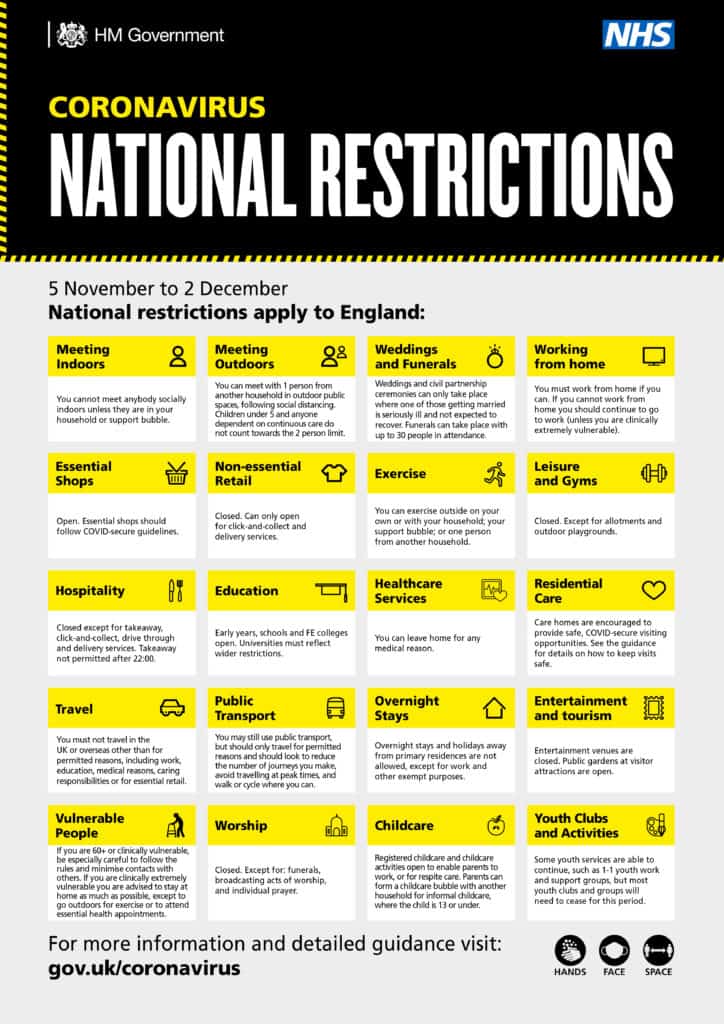Sets out the local restriction tier system that will be in place from Wednesday 2 December, including what you can and cannot do in each tier.
The current national restriction rules are still in place until 2 December and must be followed until they expire.
It is right to apply tighter restrictions where prevalence is highest. In September and October, the virus spread rapidly in all parts of the country. The government responded with new national restrictions. These have brought transmission back under control.
The government will replace them on 2 December with a regionally-differentiated approach, where different tiers of restrictions apply in different parts of the country.
These tiers will be strengthened compared to the previous tiers in order to prevent a return to growing infections. We know that social contact spreads the virus. We need to impose these restrictions and it is right to target the toughest measures only in the areas where the virus is most prevalent or where we are seeing sharper increases in the rate of infection.
The government is committed to ensuring the right levels of intervention in the right places to manage outbreaks, suppress the virus and keep R below 1.
There are 3 tiers for local restrictions:
On Thursday 26 November the government will announce which areas are in which tier. You will be able to use the postcode checker to find out the restrictions in your area or an area you plan to visit. The NHS COVID-19 app will be updated on 2 December.
The new rules will come into effect from the beginning of Wednesday 2 December.
Read more: https://www.gov.uk/guidance/local-restriction-tiers-what-you-need-to-know
Source: GOV.UK
The government’s plan for managing COVID-19 through the end of 2020 and into the start of 2021.
Read more: https://assets.publishing.service.gov.uk/government/uploads/system/uploads/attachment_data/file/937529/COVID-19_Winter_Plan.pdf
Cover: GOV.UK
While the coronavirus pandemic continues to affect the UK, tradespeople, including Green Homes Grant installers, have been advised they are still able to work in and around people’s homes under the national restrictions from 5 November.
While many other industries have been forced to stop working, our industry’s main priority is to ensure that all businesses have the right tools to perform their jobs in accordance with government guidelines.
But staying safe is a joint responsibility. That’s why we’ve launched the Work Safe Safe Work initiative, which helps businesses let their customers know what to do before, while and after tradespeople are working in and around their homes.
By informing customers of the Work Safe Safe Work downloadable guide, businesses are giving them the confidence that as an industry, we are adhering to the strict guidelines to reduce the spread of the virus, meaning tradespeople can continue working during and after lockdown.
By working together, we can keep everyone safe.
Read more: https://www.worksafesafework.info/
Source: TrustMark
How important is ventilation and how does it keep you safe from COVID-19? WHO’s Dr Maria Neira explains in Science in 5.
Watch/listen in full here: https://www.who.int/emergencies/diseases/novel-coronavirus-2019/media-resources/science-in-5/episode-10---ventilation-covid-19
Source: https://www.who.int/

Workers across the United Kingdom will benefit from increased support with a five-month extension of the furlough scheme into Spring 2021, the Chancellor announced today, 5 November.
Read more: https://www.gov.uk/government/news/government-extends-furlough-to-march-and-increases-self-employed-support
Cover photo: GOV.UK